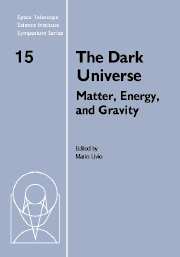Book contents
- Frontmatter
- Contents
- Participants
- Preface
- A brief history of dark matter
- Microlensing towards the Magellanic Clouds: Nature of the lenses and implications on dark matter
- Searching for the Galactic dark matter
- Hot gas in clusters of galaxies and ΩM
- Tracking the baryon density from the Big Bang to the present
- Modified Newtonian Dynamics and its implications
- Cosmological parameters and quintessence from radio galaxies
- The mass density of the Universe
- Growth of structure in the Universe
- Cosmological implications of the most distant supernova (known)
- Dynamical probes of the Halo Mass Function
- Detection of gravitational waves from inflation
- Cosmological constant problems and their solutions
- Dark matter and dark energy: A physicist's perspective
Preface
Published online by Cambridge University Press: 21 August 2009
- Frontmatter
- Contents
- Participants
- Preface
- A brief history of dark matter
- Microlensing towards the Magellanic Clouds: Nature of the lenses and implications on dark matter
- Searching for the Galactic dark matter
- Hot gas in clusters of galaxies and ΩM
- Tracking the baryon density from the Big Bang to the present
- Modified Newtonian Dynamics and its implications
- Cosmological parameters and quintessence from radio galaxies
- The mass density of the Universe
- Growth of structure in the Universe
- Cosmological implications of the most distant supernova (known)
- Dynamical probes of the Halo Mass Function
- Detection of gravitational waves from inflation
- Cosmological constant problems and their solutions
- Dark matter and dark energy: A physicist's perspective
Summary
The planet Uranus was discovered in 1781 by the British astronomer William Herschel. Not long after its discovery, astronomers charting the orbit of Uranus found small discrepancies between the predicted and observed positions of the planet. In September 1845, British astronomer John Adams proved mathematically that the deviations in Uranus' orbit could not result merely from the gravitational pull of the other known planets and he predicted the existence of another, previously undetected planet in the solar system. The eventual discovery of the planet Neptune in September 1846 by the German astronomer Johann Galle thus marked the first detection of astronomical “dark matter” whose presence was first deduced by its gravitational effects. However, in the history of physics, we also find a case in which the assumption about the existence of an unseen medium was later proven to be totally wrong. Until 1887, physicists assumed that aether—a substance that pervades all space—was a necessary medium for the propagation of light. A famous experiment by American researchers Albert Michelson and Howard Morley not only showed unambiguously that this medium does not exist, but the experimental results also set Einstein on the road to a new theory of space and time—special relativity.
Astrophysicists today are faced with a similar “Neptune vs. aether” dilemma.
- Type
- Chapter
- Information
- The Dark UniverseMatter, Energy and Gravity, pp. ix - xPublisher: Cambridge University PressPrint publication year: 2004

